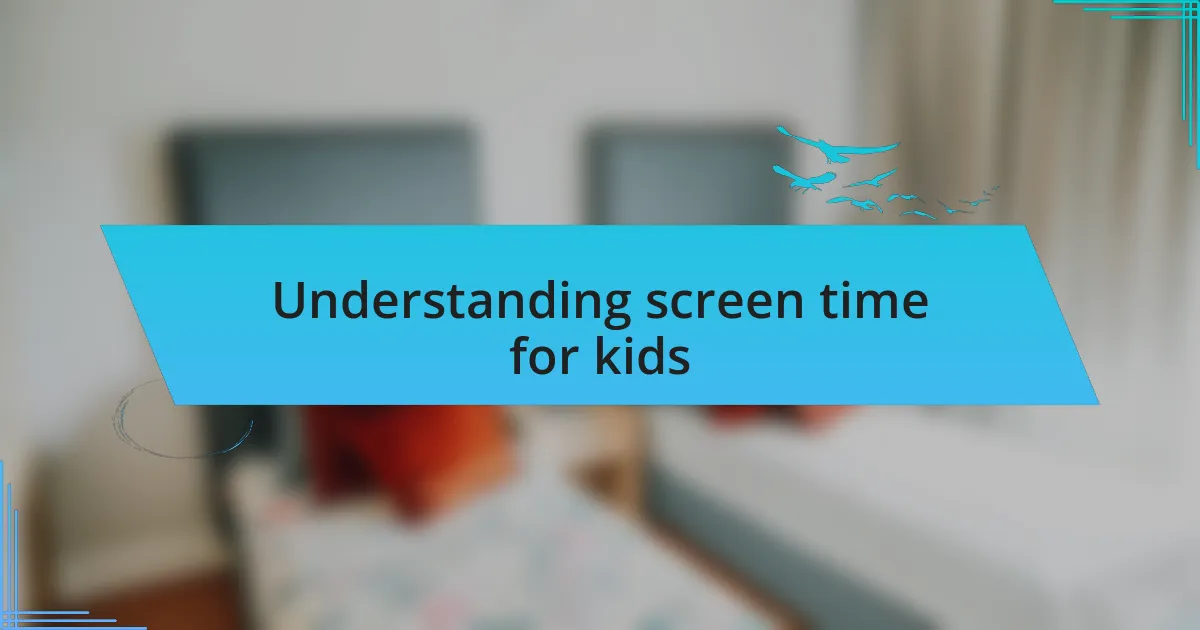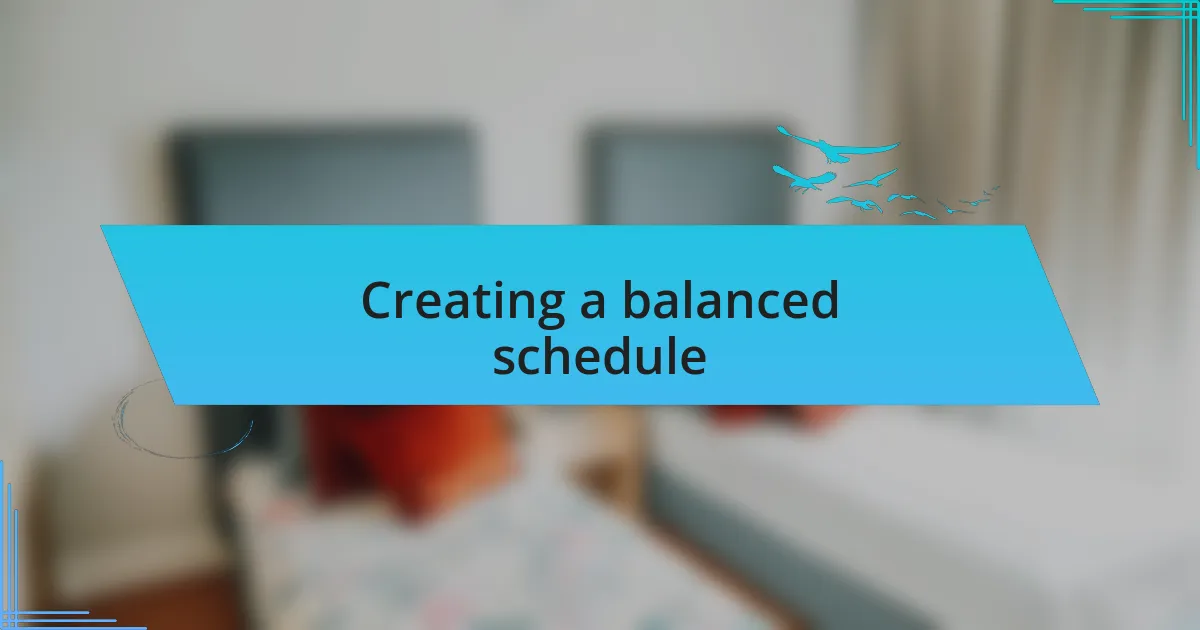Key takeaways:
- Excessive screen time can negatively impact children’s development, affecting attention, social skills, and overall engagement during family interactions.
- Establishing screen time limits while providing enriching alternatives, such as educational content and family activities, fosters healthier habits and stronger family bonds.
- Implementing strategies like scheduled screen time, collaborative content selection, and creating tech-free zones enhances family connectivity and communication.
- Encouraging alternative activities, such as arts and crafts or physical games, promotes creativity and active engagement, making family time more meaningful.

Understanding screen time for kids
Understanding screen time for kids is essential in today’s digital age. When I first became a parent, I was surprised by how quickly my child gravitated towards screens. It made me wonder: Are we unintentionally encouraging screen dependence by not setting clear limits?
Research shows that excessive screen time can affect kids’ development, leading to issues with attention and social skills. I’ve noticed this firsthand; during family dinners, my children often prefer to scroll on their devices rather than engage in conversation. Isn’t it heartbreaking to see them miss out on these precious moments?
Balancing screen time involves not only setting limits but also understanding the content they consume. For instance, I’ve found educational programs can spark curiosity and stimulate imagination, unlike mindless videos. Have you ever noticed how the right show can lead to amazing conversations about science or history? It’s a reminder that, with thoughtful choices, we can turn screen time into a meaningful experience.

Importance of managing screen time
To me, managing screen time is crucial for fostering healthy habits in kids. I remember when my own children became fixated on their devices during rainy weekends; it was a challenge to draw them outside. Setting boundaries around screen usage not only encourages them to explore the world beyond the screen but also helps them develop more balanced interests.
When I think about the importance of screen time management, I often reflect on my experience with family game nights. Those moments have become an antidote to excessive screen usage. By prioritizing family bonding over digital distractions, I’ve watched my children develop stronger communication skills. Doesn’t it feel rewarding to see them laughing together instead of being absorbed in their individual screens?
Moreover, managing screen time isn’t just about cutting back; it’s about providing alternatives that enrich their lives. I often offer to read together or embark on creative projects, which not only reduces screen dependence but also strengthens our family bond. Have you experienced how intertwining meaningful activities can create lasting memories? It’s amazing how the right balance can lead to more engaged and well-rounded kids.

Recommended screen time guidelines
I find that the American Academy of Pediatrics (AAP) recommends a guideline that suggests children aged 2 to 5 should have no more than one hour of high-quality screen time each day. I remember a time when my youngest was just four; limiting his screen time to educational programs made a noticeable difference in his attention span and creativity. What a joy it was to watch him engage in imaginative play afterwards!
For kids aged 6 and older, the AAP encourages consistent limits on screen time to ensure it doesn’t interfere with sleep, physical activity, and other essential behaviors. When I set a screen schedule at home, I noticed that my children started organizing fun outdoor activities more. Have you ever seen how vibrant their personalities can become when they’re not glued to a screen? It made me appreciate the importance of flexibility and establishing priorities.
It’s also essential to lead by example. I make it a point to unplug during family meals and activities, and I often share my own experiences of how refreshing it feels to be present in the moment. When we all put our devices aside, it creates a space where valuable conversations can blossom. Have you considered how small adjustments to your own habits can inspire kids to embrace screen time limits, too?

Strategies for effective screen management
When managing screen time, I’ve found that creating a daily schedule works wonders. For example, I allocate specific blocks of time for screens combined with alternate activities, which keeps my kids engaged without overwhelming them. Have you tried setting a timer for screen use? The countdown creates a sense of importance and anticipation that makes transitioning away from screens much smoother.
Another key strategy I’ve discovered is choosing screen time content together. I remember one weekend, we sat down as a family and picked out educational shows and interactive games. This not only made them feel included but also turned screen time into a shared learning experience. Isn’t it amazing how collaborative choices can transform a solitary activity into family bonding time?
Finally, incorporating tech-free zones in the house has been a game changer. We designated the dining room and bedrooms as screen-free areas, which promotes better family conversations and restful sleep. I can’t stress enough how refreshing it feels to gather around the dinner table without distractions. Have you considered how much deeper your connections with your kids could be when you carve out those unplugged spaces?

Creating a balanced schedule
Creating a balanced schedule involves more than just setting limits; it’s about thoughtful planning. I’ve noticed that blending screen time with outdoor play leads to a noticeable difference in my kids’ enthusiasm and mood. When I carve out time for a nature walk followed by a gaming session, their excitement is palpable. Doesn’t it feel rewarding when children can fully engage in both the digital and natural worlds?
I also believe in the power of flexibility within the routine. Some days, my kids are eager to finish their homework quickly to dive into a new video game. On those days, I adjust the schedule, allowing them some extra screen time as a reward for their responsibility. Moreover, I find that making the schedule adaptable helps them learn the importance of balancing responsibilities with enjoyment. Have you ever considered how a little flexibility could ease the tensions around screen time in your home?
To keep things engaging, I frequently review and revise our daily schedule with my kids. This collaborative approach not only empowers them but also sparks lively discussions about how they want to spend their time. One time, they suggested a family movie night in place of individual screen time, and the joy on their faces reminded me that balancing isn’t just about limits; it’s also about creating meaningful moments together. How often do we miss out on these opportunities because we stick too rigidly to our plans?

Encouraging alternative activities
Encouraging alternative activities is essential for fostering a well-rounded experience for my kids. I often suggest board games or arts and crafts as a break from screens. One rainy afternoon, we pulled out a giant canvas and some paints, and seeing them express themselves creatively was a joy that screen time simply can’t provide. Have you ever noticed how much more connected we feel as a family when we engage in hands-on activities?
I’ve also discovered the benefits of introducing educational games and science experiments. For instance, we turned a regular weekend into a mini science fair, where each child presented their own project. The excitement in their voices as they explained their experiments was contagious, reminding me that learning can happen outside of a screen. Isn’t it fascinating how these activities can ignite curiosity and encourage problem-solving skills, all while being entertaining?
Another favorite of mine is incorporating physical activities, like dance-offs or scavenger hunts. I remember hosting a scavenger hunt around the house with clues tailored for each child, which sparked giggles and team spirit. This not only kept us active but also strengthened our bond. Have you found that incorporating movement into your family’s routine makes the time spent together even more memorable?